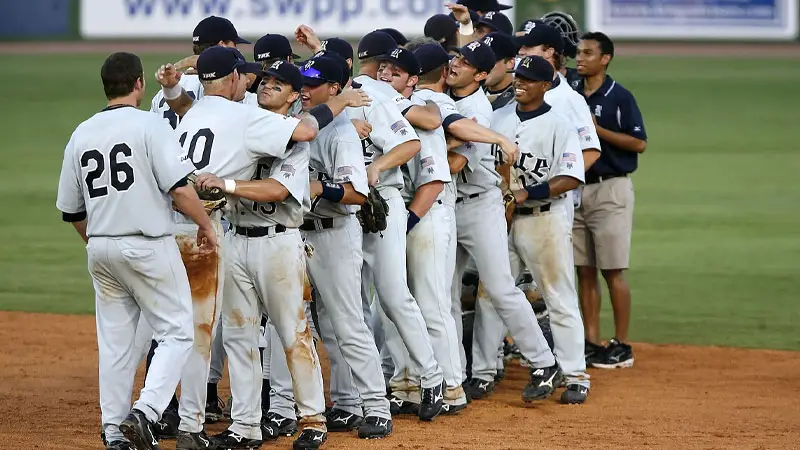The NCAA Division I baseball tournament is a thrilling journey that culminates in the prestigious College World Series.
Unlike the familiar single-elimination format of March Madness, this tournament employs a unique structure that keeps fans on the edge of their seats. With 64 teams vying for victory, the competition is fierce and the stakes are high.
The tournament kicks off with 16 regionals, each hosted by a top national seed. Within these regionals, four teams battle it out in a double-elimination format, ensuring that only the most resilient advance.
This structure might seem complex, but it adds layers of strategy and excitement, creating a captivating “survive and advance” narrative.
As the tournament progresses, the intensity only heightens. Teams that emerge victorious from their regionals move on to the Super Regionals, and eventually, eight elite teams earn the coveted spots in Omaha.
This journey showcases the grit, skill, and determination required to reach college baseball’s grandest stage.
Overview of the NCAA Baseball Tournament
The NCAA Division I baseball tournament stands as a pivotal event to crown the national champion.
Unlike typical single-elimination tournaments, this competition employs a double-elimination format, enhancing unpredictability and excitement.
Purpose and Significance
Dividing into a field of 64 teams, the tournament strives to determine college baseball’s national champion. These teams compete fiercely across various rounds, maintaining a ‘survive and advance’ theme.
Through meticulous selection by the NCAA committee, both automatic bids from conference winners and additional at-large selections shape this elite field.
Historical Context
Originating in 1947, the tournament’s format has seen multiple adaptations. Initially unrefined, it evolved into the structured and prestigious event known today.
Such developments include expanding team participation and refining competition stages, contributing to its rich legacy in collegiate sports.
Tournament Structure
Number of Teams:
A total of 64 teams compete in this prestigious event.
Selection Process:
- Automatic Bids: 30 teams earn automatic bids by winning their respective conference championships.
- At-large Bids: 34 teams are chosen by the NCAA Division I Baseball Committee based on performance, strength of schedule, and other criteria.
- National Seeds: The top 16 teams are designated as national seeds and are granted the privilege of hosting the Regionals.
Stages of Competition
In the NCAA Baseball Tournament, teams advance through distinct stages. The tournament progresses from Regionals to Super Regionals, then to the Men’s College World Series, culminating in the MCWS Finals.
1. Regionals (First Stage)
- Format: Double-elimination tournament.
- Number of Teams: 64 teams.
- Selection of Teams:
- Automatic Bids: Conference champions from 31 Division I conferences receive automatic bids to the tournament.
- At-large Bids: The remaining 33 teams are selected by the NCAA selection committee based on their regular-season performance, strength of schedule, and other factors.
- Teams are organized into 16 Regionals, each featuring four teams. The victor of each Regional, following the double-elimination format, progresses to the subsequent round.
2. Super Regionals (Second Stage)
- Format: Best-of-three series.
- Number of Teams: 16 teams (the winners from the Regionals).
- The 16 advancing teams are paired off to compete in a best-of-three series, with the 8 winners advancing to the MCWS.
3. Men’s College World Series (MCWS) – Bracket Play
- Format: Double-elimination.
- Number of Teams: 8 teams.
- These 8 teams are divided into two brackets of four. Each bracket follows a double-elimination format, with the winner of each bracket advancing to the MCWS Finals.
4. MCWS Finals (Championship Series)
- Format: Best-of-3 series.
- The winners of the 2 MCWS brackets face off in the championship series to determine the national champion.
FAQ
Brief insights into the NCAA Division I baseball tournament.
How Do College Baseball Teams Make The NCAA Tournament?
Selection for the NCAA baseball tournament involves automatic berths and at-large spots. Conference champions receive 30 automatic bids.
The NCAA Division I Baseball Committee then selects 34 at-large teams based on their regular-season performances. Factors like rankings and strength of schedule influence the selection.
When Is The NCAA Baseball Tournament Selection Show?
The NCAA baseball tournament selection show occurs on Monday, May 27, traditionally held on Memorial Day. At noon EST, the network reveals the 64 competing teams, highlighting those chosen as national seeds.
When Do NCAA Regionals Begin?
NCAA Regionals start on May 31 and conclude on June 3. These games take place on various campuses across the United States.
Regionals follow a double elimination format involving 16 four-team brackets, with the top 16 seeds acting as hosts.
When Do NCAA Super Regionals Begin?
Super Regionals are scheduled to start on June 7 or 8. These events finish either on June 9 or 10, depending on the NCAA’s tournament bracket. The remaining 16 winners from Regionals compete in best-of-three series.
When Is The 2024 NCAA College World Series?
On June 14, the 2024 NCAA College World Series kicks off. Eight teams head to Omaha, Nebraska, to compete. The series follows a two-bracket double elimination format.
When Do The College World Series Finals Start?
The finals of the College World Series begin on June 22. A third game is planned for June 24 if needed. The two bracket winners face off in a best-of-three series to determine the champion.
When Was The First NCAA College World Series?
The first NCAA College World Series took place in 1947. The event has evolved significantly, enhancing its status and appeal in collegiate sports over the decades.
Conclusion
The NCAA baseball tournament stands as a testament to the excitement and unpredictability of collegiate sports.
Its intricate structure not only tests the teams’ strategic prowess but also highlights the incredible journey from regionals to the College World Series.
With its unique blend of tradition and evolution, the tournament continues to captivate fans and players alike, celebrating the spirit of competition and the pursuit of excellence in college baseball.
As each season unfolds, the anticipation and thrill of the tournament remind us why it’s a cherished event in the sports calendar.





Pat Bloom